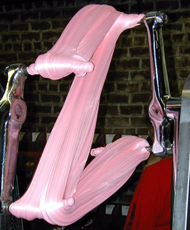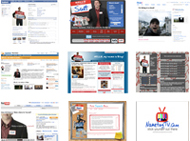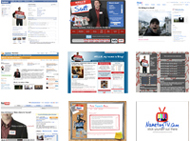 15 to 30 billion.
15 to 30 billion.
That’s the (approximate) number of websites that exist on the Internet, according to a research study published by Pandia Search World News.
This statistic leads to four crucual questions every online marketer must ask himself:
1. Why would someone come to (and stay at) my website for more than 60 seconds?
2. Why would someone give me her email address (and therefore, permission) to market to her regularly?
3. Why would someone return to my website consistently?
4. Why would someone tell her friends about my website consistently?
The good news is, all four of these questions have the same answer:
You don’t need a website –- you need a destination.
There’s a MAJOR difference between these two words.
First, let’s talk about the word “website.”
I actually looked up the word website in the dictionary for the first time today.
It’s defined as, “A set of interconnected web pages prepared and maintained as a collection of information by a person, group, or organization.”
zzzzzzzzzzzzzzzzzzzz…
(Oh, sorry. I dozed off there for a sec!)
Mainly because a “website” is B-O-R-I-N-G.
Hell, there are like 14,999,999,999 other ones out there besides yours!
See, a “website” is not going to get people to come TO, hang out AT and tell their friends ABOUT anything. It needs to be MUCH more than just information.
It needs to be interactive.
It needs to be participative.
It needs to be updated regularly.
It needs to be THEE source, THEE go-to-place, the El Dorado, The Mecca … for a certain kind of people who want a certain kind of thing.
That’s a destination.
It needs to scream, “Here’s EXACTLY what you were looking for!” and not, “Hey, look at me! I’m a cool, flashy website with a dancing Alligator!”
That’s a destination.
Most importantly, it needs to be the LAST place your customers look for whatever it is they need.
That’s a destination.
Which, by the way, is defined as “the ultimate purpose for which you are destined.”
Wow. Has a nice ring to it, doncha think?
SO, ASK YOURSELF THIS: Do your customers want “A set of interconnected web pages,” or “the ultimate purpose for which they are destined”?
I think you know the answer to that question.
* * * *
Of course, the big challenge is transforming your website INTO a destination.
The first thing you need to do is evaluate your present site. Ask yourself (and your team) these ten questions:
1. Does your site leave a perception of value or vanity in the mind of a visitor”?
2. How are you getting customers to come back to your site just to see what you’ve been up to?
3. Is content king on your site?
4. Is your site an experience?
5. What are the Potential Silent Dialogues when visitors first come to your site?
6. When someone comes to your site, how do you want him to feel?
7. When someone comes to your site, what’s the ONE THING you want him to do?
8. When was the last time you added new content to your site?
9. When was the last time you invited your visitors to participate at your site?
10. Why would anyone spend more than 60 seconds at your site?
OK, now that you’ve gauged the effectiveness of your present site, it’s time to transform it into a destination!
NOTE: this IS an ongoing process. It may take months or even years! So, consider the following ideas simply as starting points. (And be sure to click through to each of the examples to see the principle in action!)
1. Build a permission asset. Seth Godin defines this as, “The privilege (not the right) to deliver anticipated, personal and relevant ideas to the people who CHOOSE to get them.”
So, use ezines, blogs, RSS feeds, widgets, ebooks or subscriptions to build your list. Get their email!
DESTINATION #1: www.gitomer.com
2. Content is king. Whether it’s articles, blog posts, videos, pictures, audio files, transcripts, tips, recipes or PDF’s, have enough content to keep people around.
If you get emails from people who say, “I just spent the last three hours on your website!” consider that a mark of a TRUE destination.
DESTINATION #2: www.faith.com
3. Foster community. With the advent on online social networking, web users are looking for other people with like-minded interests and worldviews to share and connect with.
So, make the site about connecting other people to each other, while occasionally promoting yourself. Make it about them. Give them a platform and they’ll be all the marketing you’ll ever need.
DESTINATION #3: www.squidoo.com
4. Membership. Offer various levels of involvement. Have free trials available. Get people hooked so they come back on a regular basis.
This not only creates subscription-based passive income, but works hand in hand with your permission asset.
DESINTATION #4: www.visualthesaurus.com
5. Regular updates. “Websites” are like newspapers: nobody wants to read them if they’re two years old. So, for your “destination,” consider embedding a blog into the site, or having regular updates, quotes, questions, videos, pictures or other forms of revolving content.
Cause people to think, “I should go back to that site and see what they’re up to today!”
DESTINATION #5: www.mobuzz.tv
– – –
These self-assessment questions and destination examples should be enough to convince you of the following face: websites are meaningless and destinations are magnificent!
So, be honest with yourself. Think hard.
Do you have a website or a destination?
LET ME ASK YA THIS…
What makes your site a destination?
LET ME SUGGEST THIS…
But Seth’s new book. Where do you think I got all these ideas? 😉
* * * *
Scott Ginsberg
That Guy with the Nametag
 Enjoy this post?
Enjoy this post?
If so, perhaps I could help on a more personal, one-on-one basis.
Rent Scott’s Brain today!

 Let’s talk about “tolerance.”
Let’s talk about “tolerance.” Enjoy this post?
Enjoy this post? Why?
Why? Enjoy this post?
Enjoy this post?
 Enjoy this post?
Enjoy this post?
 Enjoy this post?
Enjoy this post? Oscar Wilde once remarked, “The only thing worse than being talked about is NOT being talked about.”
Oscar Wilde once remarked, “The only thing worse than being talked about is NOT being talked about.” Enjoy this post?
Enjoy this post? I’ve been reading Joe Meyers’ new book,
I’ve been reading Joe Meyers’ new book,  Enjoy this post?
Enjoy this post? In the month of October alone,
In the month of October alone,  Are you a friend of
Are you a friend of  You’re not an expert.
You’re not an expert. Are you a friend of
Are you a friend of  Just finished an interview with my new friend, Dean Jackson, from
Just finished an interview with my new friend, Dean Jackson, from  Are you a friend of
Are you a friend of